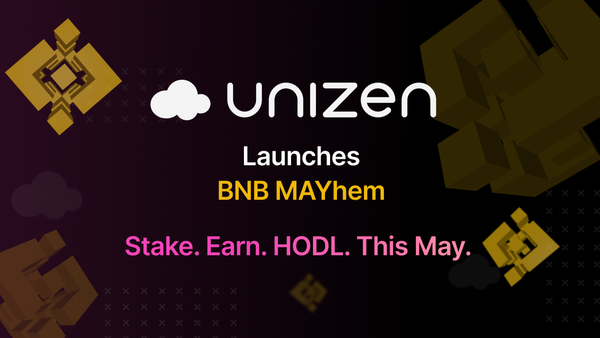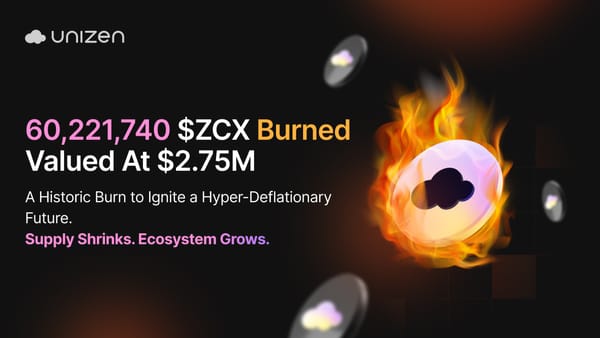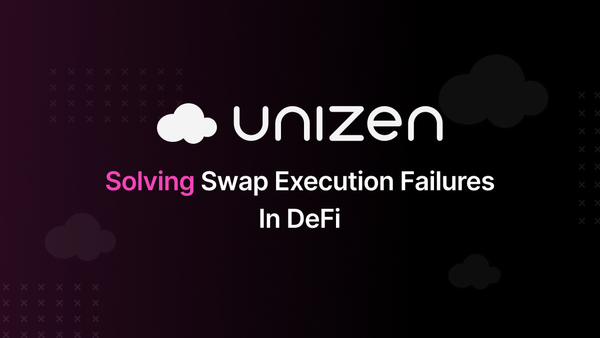What is Ethereum Surge on the Ethereum Roadmap?
What is Ethereum surge, and how is it using zero-knowledge proofs to develop scaling technologies to help increase transactions on the Ethereum network?

Ethereum has evolved into one of the world's most important and influential blockchain networks. Developments related to Ethereum, particularly those involving the Ethereum mainnet, are being closely monitored. Platforms like Unizen monitor them to ensure that integrations will happen seamlessly with decentralized applications as Ethereum continues down its road of scalability. However, to truly realize its potential and handle the demands of a rapidly growing decentralized application ecosystem, it needed to upgrade its underlying infrastructure. What is Ethereum surge? The Surge is one of the crucial and critical developmental milestones on Ethereum’s multiple-phased progress map with regard to shifting the network from a proof-of-work consensus mechanism, which is vastly energy and time-consuming, to a far more effective proof-of-stake mechanism. In terms of its chronology, this stage occurred in early 2022; core developers, the Ethereum community, and its co-founder, Vitalik Buterin, carried out important optimizations, upgrades, and tests to prepare the network for upcoming crucial alterations.
One of the primary objectives of the Surge was to significantly improve the scalability and transaction throughput of the Ethereum network. As the platform grew in popularity, the increasing demand pressured the blockchain's capabilities. To help address challenges and prepare the network for future usage, a core focus of the Surge was enhancing Ethereum's underlying infrastructure with data blobs. Goals included optimizing the network stack to allow faster block propagation, implementing protocol optimizations like data sampling to reduce node syncing times, performing tests to identify bottlenecks, and integrating client improvements.
Upgrades during the Surge optimized how blocks were processed and reduced delay times and bandwidth usage. This boosted Ethereum's ability to support decentralized apps and transactions. The improvements prepared the network for even more powerful scalability upgrades, including proto-danksharding, coming later. Upgrades like splitting the network into pieces (sharding) and switching to a proof-of-stake system will improve scalability. By achieving its goals, the Surge was an important stepping stone in Ethereum's long-term plan to advance the technical abilities of the blockchain in major ways. It established itself as a pivotal time that moved Ethereum's roadmap towards realizing Ethereum's full potential.
Key Components of the Ethereum Surge
Here are the key components of the surge. Put together, these techniques will make Ethereum a more scalable and efficient platform for decentralized applications.
Sharding
Sharding is a scaling solution that segregates the blockchain's data and computation load into smaller fragments, known as "shards." This approach will enable platforms such as Unizen to build on Ethereum for real-world applications using Ethereum's high scalability. Each shard processes its own transactions and smart contracts independently. This enhances the network's overall capacity by distributing the computational workload across multiple shards, allowing for parallel processing as envisioned in the Ethereum 2.0 roadmap, particularly through data sharding.
Sharding Increases Transaction Throughput
By splitting the network into multiple shards, each one can process its subset of data and transactions, allowing for more simultaneous transaction processing. This increases the total throughput. Importantly, the cross-shard communication mechanisms must be strong enough to keep the transaction data in one shard and continue with either transactions or smart contracts in another, ensuring network efficiency. Sharding enables the blockchain to process more TPS without overloading the network.
Danksharding
Danksharding is an evolution in sharding proposals, particularly for Ethereum. Its key innovation is data availability sampling and the use of blobs to handle large amounts of data off-chain in a highly scalable manner.
Role of Blobs in Danksharding
A blob is this big chunk of information that can be kept off-chain but, at the same time, still made accessible to the nodes for verification on Ethereum. Other than having each data on-chain and verifying it, a validator would just confirm that the existence of data in a blob is there without downloading the whole content.
This drastically reduces on-chain storage and computation overheads while ensuring the data's availability and integrity within the Ethereum block. Danksharding, combined with settlement and data availability sampling, increases scalability without compromising security. By focusing on blobs for data, this approach enables Ethereum developers to process large amounts of data more efficiently while ensuring that data remains verifiable and accessible on the EVM.
Layer 2 Rollups
Layer 2 rollup operations are designed to transfer the burden of executing transactions from Layer 1 which is the Ethereum chain. While they can be executed off-chain, they offer Ethereum’s security assurances to increase the efficiency of the Ethereum Virtual Machine as a whole. This might be critical for projects such as Unizen, which tries to offer high-performance trade execution with Ethereum's security.
Two key types of rollups
- Optimistic Rollups: These assume transactions are valid by default, enhancing scalability on the Ethereum mainnet. A fraud-proof mechanism is triggered to validate the transaction if a challenge arises. Optimistic rollups rely on a period during which fraud can be detected, usually several days.
- ZK-Rollups (Zero-Knowledge Rollups): ZK-rollups generate cryptographic proofs (specifically validity proofs) that can be verified on-chain. This provides a more immediate assurance of correctness than is possible with an optimistic rollup, as the proofs illustrate the correctness of each batch of transactions with no delays.

Impact on Gas Fees and Network Efficiency
- Reduced gas fees: Rollups bundle many transactions into a single batch and post only the proof or the result of the batch on-chain. This greatly reduces the amount of on-chain computation, resulting in lower gas fees per transaction.
- Higher transaction throughputs: By taking the execution and state changes off-chain, rollups can process many transactions in parallel. This greatly raises the throughput and reduces the load on Ethereum's base layer.
- Network Efficiency: By removing the majority of computation and storage from the base layer, Ethereum will be able to pay more attention to security and decentralization. This will allow for scalability and enhance the network's general efficiency. This helps to reduce the network congestion.
Technical Advancements in the Surge
Here are some of the recent technical advancements:
Blob-Carrying Transactions
Traditionally, blockchain transactions carried only references to data rather than storing larger payloads directly on the Ethereum mainnet, but advancements in data storage are changing that. This imposed limits on what could be decentralized. New developments allow transactions to carry "blobs" or binary large objects. Nevertheless, such blobs are not saved on the Ethereum chain in permanency. Rather, they are mentioned in passing as temporality such as in the EIP-4844 (Proto-Danksharding) where blobs go off-chain but are retrievable to check veracity for a limited time. This enables storing files, media, documents, and other payloads directly on-chain, facilitating data back to Ethereum.
Benefits include:
- Decentralized storage of rich content like videos, images, and medical records without needing off-chain storage.
- Ability to timestamp, notarize, and prove the integrity of documents without centralized intermediaries.
- Facilitates distribution of digital goods, media, and software updates directly via the blockchain.
- Removes single points of failure compared to traditional centralized hosting. Content remains available as long as the referenced blobs are accessible if any individual node fails.
Data Availability Sampling
With blobs, large amounts of data can be embedded in decentralized networks. However, requiring every node to store all data reduces nodes' ability to join over time as the ledger grows. In data availability sampling applied in sharding as seen in Danksharding, efficient partial replication is obtained since only a subset of nodes stores certain blobs, while periodic random checks verify data integrity. For example, 10% of nodes may store a blob, with random nodes verifying that others still have it on request, enhancing data storage efficiency in the Ethereum network.
Benefits include:
- Ensures long-term persistence and accessibility of embedded data as network participation changes.
- Reduces infrastructure costs as not all nodes need to store all data.
- Byzantine fault tolerant - sampling detects issues even if some nodes fail to store assigned data.
Challenges and Risks Associated with the Surge
Sharding and data availability sampling introduce significant technical complexity that requires careful testing and evaluation. While sharding promises huge gains in scalability, synchronizing states across independent shards and ensuring data integrity through sampling poses major challenges. Sampling strategies must be robust against errors or faulty validators, but perfect sampling is impossible. Omissions or inaccuracies in sampled state data could compromise individual shards over time. A phased rollout, starting with fewer larger shards, would allow these issues to be stress-tested and addressed at a manageable scale before widespread deployment. Incremental upgrades allow redundancy and error correction strategies to evolve alongside the technology.
The increased data loads from massive scaling also introduce centralization risks if only the most resource-intensive nodes can participate. Gradually ramping up capacity over several upgrade cycles allows time for technologies like decentralized cloud computing and serverless architectures to emerge and support a more diverse set of node operators. Smaller players mustn't be phased out before these solutions mature. Likewise, sudden reductions in gas fees aimed at high transaction volume risks could subsidize harmful spam or cryptocurrency attacks. Careful economic modeling and congestion controls are needed to incentivize positive activity without compromising the costs of bad behavior on the network.
Finally, integrating Layer 2 rollups seamlessly with Layer 1 settlement poses a significant coordination challenge. Rolling out variants like zk-rollups and optimistic rollups in staggered phases allows potential integration issues or inconsistencies between designs to surface at lower stakes. It also gives developers time to standardize bridging, exits, and other interoperability protocols between the layers. With an incremental, community-driven process of deployment and review, the technical complexity of scaling Ethereum can be navigated to achieve massive throughput while preserving decentralization and security. No solutions should be rushed without prudent evaluation of risks.

Impact on Ethereum Network Performance
Here are insights into how recent Ethereum improvements are expected to impact network performance:
Transaction Speed
The shift to proof-of-stake with the Merge aims to significantly reduce average transaction settlement times from over a minute currently to as little as 2-3 seconds. Faster block times enabled by PoS will allow transactions to be batched more frequently into new blocks. Transaction backlogs should clear out more rapidly, improving user experience and facilitating faster withdrawal processes on the Ethereum network.
Transaction Costs
EIP-1559 introduced a base fee that acts as a guideline for gas costs. This economic layer helps stabilize fees during periods of high utilization. It also makes fees more predictable for users. The upcoming update to base fee adjustment is expected to make gas prices more responsive to network demand fluctuations in real-time, helping mitigate network congestion. This will lead to even less volatility in transaction costs over time.
Scaling to 100,000 TPS
Current Layer 1 Ethereum achieves around 15-30 transactions per second. Further layer 1 upgrades like sharding are needed to reliably process over 100,000 TPS as intended. Sharding will split Ethereum data and transactions across 64 new blockchains called shards, each processing transactions in parallel. This distributing of work across many shards has the potential to scale transaction throughput to over 100,000 TPS while maintaining security, aligning with Ethereum Improvement Proposals. However, sharding remains in the late development stages, and full transition may take 18-24 months after the Merge, according to estimates. Incremental scaling in the interim will come from rollups, which can currently handle 1,000s of TPS, enhancing Ethereum's consensus mechanism from proof-of-work.
Comparison with Previous Upgrades
Here is a comparison of the Ethereum Merge and Surge upgrades:
The Merge
Occurred on September 2022. It completed Ethereum's long-planned transition from a proof-of-work to a proof-of-stake consensus model. This involved upgrading the existing execution layer (Frontier, Homestead, etc) to merge with the new Beacon Chain. It started its operation in 2020 and has been operating parallel to it, intending to improve the future of the Ethereum ecosystem through a proof of stake consensus. Thus dozing off the power-hungry likelihood of mining, it achieved the objective of making Ethereum much cleaner and more sustainable for ether owners. Also, it is more secure in the long term against threats like lengthening block times or 51% attacks that afflict proof-of-work networks. However, it didn't improve the scalability or the throughput performance much, with transactions standing at around 15-30 TPS even after the merge. This was never the intended purpose - it primarily focused on establishing a foundation for future upgrades.
The Surge
Encompasses multiple upcoming upgrades to scalability of the Ethereum execution environment over the next 2 years, enabled by the proof-of-stake model established by the Merge. These include sharding, stateless client execution, eWASM upgrades, data availability sampling via EIP-3442, bidirectional payment channels like Rollups, and Geth v2.0 rewrite. Together, these aim to optimize and parallelize transaction throughput via techniques like sharding the database across up to 64 new blockchains that can process transactions independently. Estimates indicate this 'Surge' of upgrades could scale Ethereum to over 100,000 TPS by 2025 if development milestones are met on schedule. It directly solves the scalability problem, whereas the Merge solves the consensus and sustainability challenges to lay the foundations for solutions like shard chains.
Here are some key ways that the Ethereum Surge upgrades build upon the foundations laid by the Merge:
- Sharding enabled: The proof-of-stake consensus model established in the Merge allows splitting the database across multiple parallel "shards," each processing transactions independently. This enables massive scaling that wasn't feasible under proof-of-work.
- Security model reinforced: Sharding and other surge upgrades rely on the robust proof-of-stake security provided by validators after the Merge transition, ensuring the integrity of transaction data. This gives confidence in the security of sharded transaction processing.
- Flexibility for innovation: Proof-of-stake introduced greater flexibility to the backbone that permits more advanced transaction processing techniques like stateless client execution and bidirectional payment channels.
- Ecosystem alignment: By achieving the switch to proof-of-stake, the Merge creates full alignment across client teams and the much larger ecosystem for smoothly developing surge upgrades, enhancing the consensus mechanism.
- Performance-optimized backbone: Post-merge optimizations like reduced block times create a faster underlying transaction settlement framework, improving the responsiveness of surge layer upgrades.
- Sustainability assured: The eco-friendliness of proof-of-stake established in the Merge ensures Ethereum 2.0 can support additional transaction load from surge upgrades without new energy/carbon costs.
- Multi-stage roadmap: The Merge was step one of several planned phases. It has always intended to enable the next steps, such as sharding and statelessness, that the surge brings closer to reality.
Conclusion
Ethereum Surge is a third-generation blockchain and seeks to solve some scalability issues on the Ethereum network. Employing zero-knowledge proofs, along with other novel cryptographic techniques, it's hoped that Ethereum Surge will be able to operate a network that is significantly faster and cheaper without compromising on decentralization or security. If successful, Ethereum Surge could allow the Ethereum network to process thousands to tens of thousands more transactions per second, making decentralized applications on Ethereum faster and affordable for mainstream use. Only time will tell if Ethereum Surge lives up to its ambitions, but its novel approaches to scaling, including EIP-4844, make it one to watch in the ongoing evolution of Ethereum Surge. Ethereum Surge has the potential to help drive broader adoption of not just Ethereum but also decentralized technologies as a whole. Platforms like Unizen are well-positioned to take advantage of this scalable future in the crypto space, providing faster, more affordable solutions.



